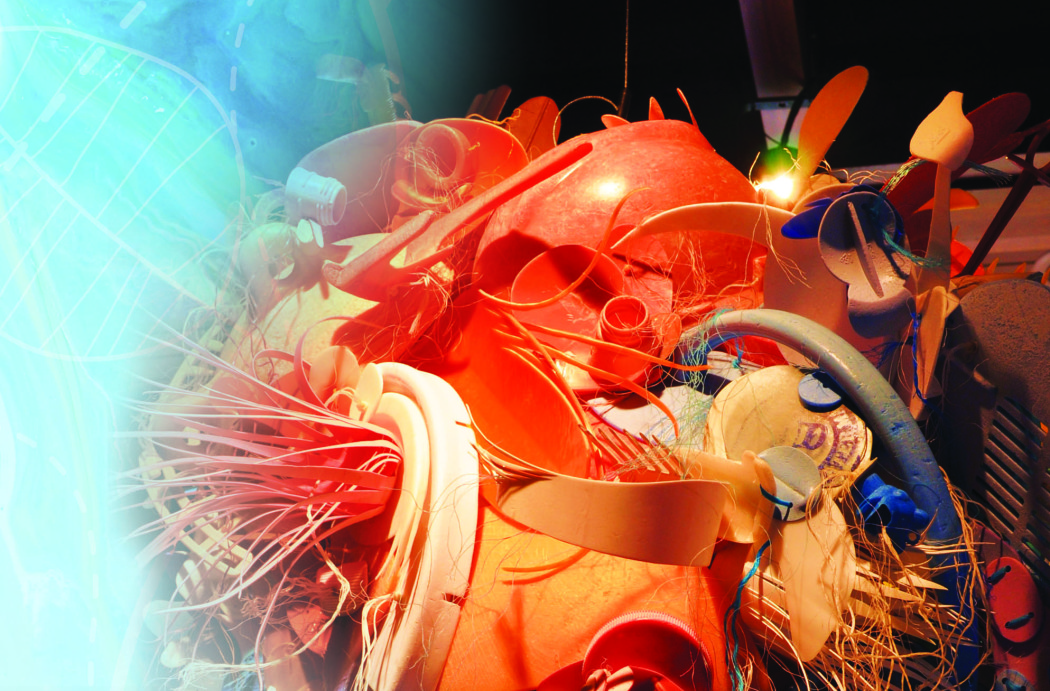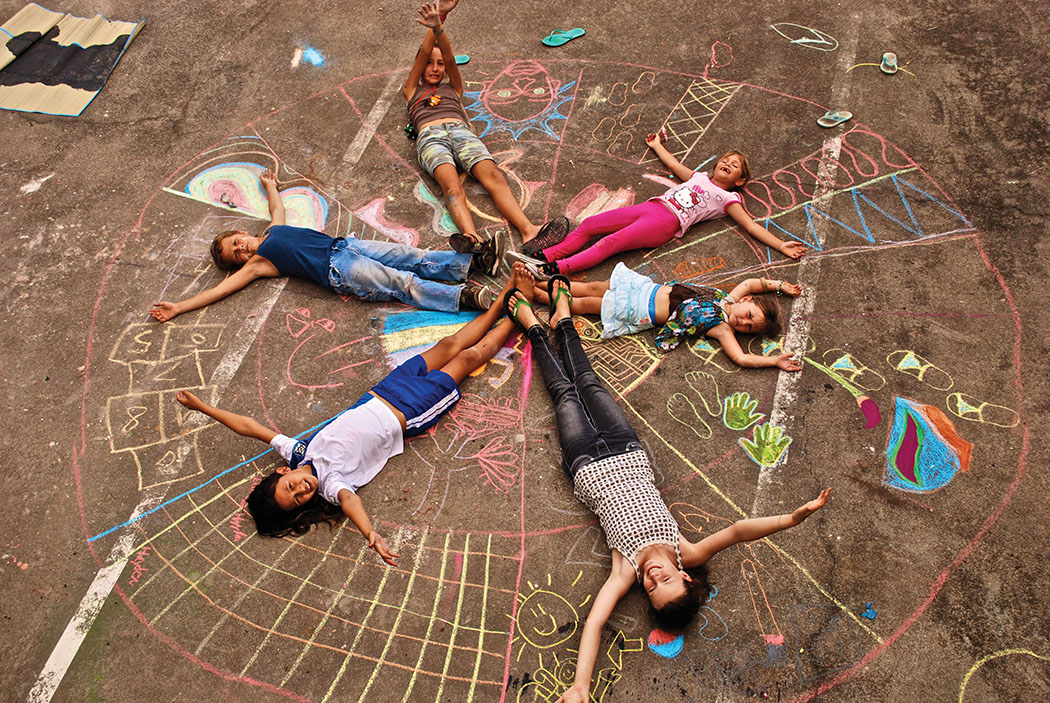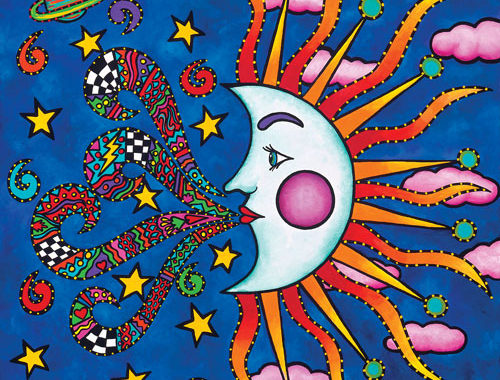
Ocean Trash Art: Ocean Debris Becomes a Work of Art
 By Devany Vickery-Davidson
By Devany Vickery-Davidson
Few people have the talent and the vision to literally take trash to an art form. Hawai‘i Island was fortunate to have a visitor here in January that did just that. Aurora Robson, an artist who was raised in Maui and now lives in New York City, was commissioned by the Waimea Ocean Film Festival to create a large sculpture using plastic that arrived on Kamilo Point, near South Point, from the Pacific Gyre.
What was once an assortment of toothbrushes, soap bottles, fisherman’s floats, buckets, fishing nets, soda bottles, children’s toys and many other plastic items is now an intricate, multidimensional sculpture, full of color and light, called Kamilo.
Aurora and the students of Parker School worked for weeks cleaning, sanitizing and sorting the plastic. It is not an easy job to remove chemical residue and all of the soil and contaminates that build up along the plastics’ voyage to land. Once this junk hits our shores, it sits in the sun, baking and becoming an eyesore that does not decompose. Through the efforts of the Hawaiian Wildlife Fund and the Waimea Ocean Film Festival, the plastic was reclaimed as art materials for the sculpture.
The project not only made art from trash, it also educated people (most particularly the students at Parker School.) After all of the trash was cleaned and separated by color, some of the pieces were cut up and others were left in their original state. The work was all done in the art room of Parker School, which also has a lanai—crucial for the cleaning and air-drying process. All organic materials were used to clean and sterilize the plastic. Volunteer students arrived at the art room each day and were given a variety of assignments by Ms. Robson, who also had her husband along as assistant and caregiver for their young daughter, who also traveled here with the couple. The studio was open for film festival attendees and community people to visit each day of the festival before the completed sculpture was moved to the Four Seasons Hualalai for the closing ceremonies.
We rarely see mounds of flotsam and debris on the shores of our island because of the way the currents flow to Hawai‘i. Most of the trash that washes up on our beaches ends up on the sparsely populated southeast coast of the island. Many people are aware of the giant plastic island floating in the North Central Pacific known as the Great Pacific Garbage Patch or the Pacific Gyre. Last year the Hawai‘i Wildlife Fund gathered mountains of plastic and other trash near Kamilo Point on the southeast coast of the Big Island. It was part of an annual clean-up effort there, because Pacific Ocean currents flow toward and converge at this point. Some of the flotsam at Kamilo Point was worthy of recycling in a variety of ways; much of it was just plain refuse, or in Hawaiian, ‘opala. Through this project mountains of plastics which are not so easily recycled all found a better and higher calling as art.
Aurora has had several commissions and exhibits of her art from plastic refuse. She also has developed a keen sense as to what can be used in her work. In this situation Aurora was using more brittle plastics, which had seen lots of time in the sun and salt water. Instead of riveting her pieces together as she usually does, she had to find a solution to the delicate nature of plastics that had been exposed to the elements. For this she developed a system where she drilled through the plastic and used fishing line (also found to a great degree on Hawaiian shores) to tie it together. With heat guns she was able to manipulate some of the softer plastics into a variety of forms after carving them into smaller and more delicate pieces.
Back home in New York, Ms. Robson continues to work on her art in recycled plastics. Some of her pieces fill entire rooms as installations. One, entitled “The Great Indoors,” is a 44 x 40 x 16-foot sculpture utilizing 15,000 used drinking bottles. Some of her work is illuminated with solar lights as chandeliers and a few pieces hang inside prestigious buildings around the world. Others are on a slightly smaller scale, but still quite large compared to some sculptures.
Aurora works carefully to try to lure the viewer into the sculpture and away from the various brand names and shapes that plastics often define, though in this sculpture she left in a few tiny remnants of recognizable plastic: a surfer, an army man, a toy horse and a few toothbrushes. In the case of this work she was able to identify containers from Russia, China and South America and she shared this knowledge with the Parker School students who were working with her. The tides brought Robson the tools and raw materials of her art and, as an artist, she applied her talents to creating a sculpture of amazing beauty from the plastic trash—items which would otherwise be littering the beaches
of Hawai‘i.
Aurora recalls her years growing up on Maui as significant inspiration to her art. She said, “I remember the natural magnificence of the Haleakala Crater, eucalyptus forests, black sand beaches and picking lilikoi off wild vines. It instilled a sense of honor in me, not just for the Hawaiian Islands, but for the e
ntire planet.
As ironic as it must seem when viewing her beautiful and graceful sculptures, her creativity was born out of childhood nightmares. She focuses her energies to shift negative trajectories into works of art that are positive and uplifting. It is difficult to imagine someone viewing her art without lips curling into a smile, and often the work engages people in conversation.
The actual construction of this immense sculpture (which looks somewhat like a giant koi) took more than ten days to complete before its unveiling at the Four Seasons Hualailai Resort for the end of the festival celebration. The completed, hanging sculpture will go up for auction at the 2012 Waimea Ocean Film Festival. It will be on display during the festival, so feel free to come by and take a look at it in person.
Big Island resident Tania Howard, the founder of the festival, has made it her goal to include art in the Waimea Ocean Film Festival in a variety of ways. The festival itself is based upon all things related to the ocean. Many of the films are about the fragile ecology of the oceans and our responsibility to care for this precious resource. Throughout the festival, Hawaiian cultural teachers help participants understand the Hawaiian reverence for the land and the sea. The west Hawaiian voyaging society, Na Kalai Wa’a Moku o Hawai‘i hosts breakfast talks and evening activities to share with participants these cultural values, knowledge about the voyaging canoes, the ancient art of wayfinding, and the old stories and culture. ❖
Resources
You can find out more about this and other art featured as part of the Waimea Ocean Film Festival at www.waimeaoceanfilm.org
For more information about Aurora Robson and her work go to her website: www.aurorarobson.com


